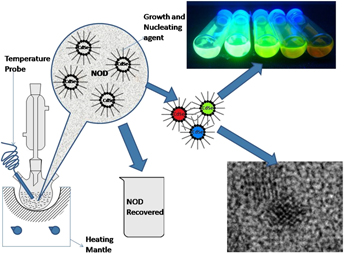Crossref Citations
This article has been cited by the following publications. This list is generated based on data provided by
Crossref.
D’Souza, Laveena P.
Amoli, Vipin
Chandan, H.R.
Sinha, Anil Kumar
Krishna Pai, Ranjith
and
Balakrishna, Geetha R.
2015.
Atomic force microscopic study of nanoscale interaction between N719 dye and CdSe quantum dot in hybrid solar cells and their enhanced open circuit potential.
Solar Energy,
Vol. 116,
Issue. ,
p.
25.
D'Souza, Laveena P.
Muralikrishna, Sreeramareddygari
Chandan, Hunsur R.
Ramakrishnappa, Thippeswamy
and
Balakrishna, R. Geetha
2015.
Neodymium doped titania as photoanode and graphene oxide–CuS composite as counter electrode material in quantum dot solar cell.
Journal of Materials Research,
Vol. 30,
Issue. 21,
p.
3241.
R, Chandan H.
Venkataramana, M.
Kurkuri, Mahaveer D.
and
Balakrishna R, Geetha
2016.
Simple quantum dot bioprobe/label for sensitive detection of Staphylococcus aureus TNase.
Sensors and Actuators B: Chemical,
Vol. 222,
Issue. ,
p.
1201.
H. R, Chandan
Schiffman, Jessica D.
and
Balakrishna, R. Geetha
2018.
Quantum dots as fluorescent probes: Synthesis, surface chemistry, energy transfer mechanisms, and applications.
Sensors and Actuators B: Chemical,
Vol. 258,
Issue. ,
p.
1191.
Kumar Y. V. V., Aswani
R. M., Renuka
J., Achuth
Mudili, Venkataramana
and
Poda, Sudhakar
2018.
Development of a FRET-based fluorescence aptasensor for the detection of aflatoxin B1 in contaminated food grain samples.
RSC Advances,
Vol. 8,
Issue. 19,
p.
10465.
Hunsur Ravikumar, Chandan
Ira Gowda, Manjunath
and
Balakrishna, R. Geetha
2019.
An “OFF–ON” quantum dot–graphene oxide bioprobe for sensitive detection of micrococcal nuclease ofStaphylococcus aureus.
The Analyst,
Vol. 144,
Issue. 13,
p.
3999.
Vishaka, Halali V.
Saxena, Manav
Chandan, H.R.
Ojha, Anupam Anand
and
Balakrishna, R. Geetha
2019.
Paper based field deployable sensor for naked eye monitoring of copper (II) ions; elucidation of binding mechanism by DFT studies.
Spectrochimica Acta Part A: Molecular and Biomolecular Spectroscopy,
Vol. 223,
Issue. ,
p.
117291.
V. H., Vishaka
Saxena, Manav
R., Geetha Balakrishna
Latiyan, Sachin
and
Jain, Shilpee
2019.
Remarkably selective biocompatible turn-on fluorescent probe for detection of Fe3+ in human blood samples and cells.
RSC Advances,
Vol. 9,
Issue. 47,
p.
27439.
Hunsur Ravikumar, Chandan
R, Shwetharani
and
Balakrishna, R. Geetha
2020.
Surface modified glass substrate for sensing E. coli using highly stable and luminescent CdSe/CdS core shell quantum dots.
Journal of Photochemistry and Photobiology B: Biology,
Vol. 204,
Issue. ,
p.
111799.
George K, Jesna
Halali, Vishaka V
C. G., Sanjayan
Suvina, V.
Sakar, M.
and
Balakrishna, R. Geetha
2020.
Perovskite nanomaterials as optical and electrochemical sensors.
Inorganic Chemistry Frontiers,
Vol. 7,
Issue. 14,
p.
2702.
Halali, Vishaka V.
and
Balakrishna, R. Geetha
2020.
An expeditious method for the ultra-level chemosensing of uranyl ions.
Analytical Methods,
Vol. 12,
Issue. 8,
p.
1070.
Hunsur Ravikumar, Chandan
Nair G., Vishnu
M. P., Raghavendra
Surareungchai, Werasak
Thakur, Archana
and
Balakrishna, R. Geetha
2021.
Biomass derived carbon dot decorated ssDNA for a ‘turn-on’ fluorescent assay for detection ofStaphylococcus aureusMNase.
New Journal of Chemistry,
Vol. 45,
Issue. 13,
p.
5890.
Ünlütürk, Seçil Sevim
Çaǧır, Ali
Varlıklı, Canan
and
Özçelik, Serdar
2021.
1-Octanol Is a Functional Impurity Modifying Particle Size and Photophysical Properties of Colloidal ZnCdSSe/ZnS Nanocrystals.
The Journal of Physical Chemistry C,
Vol. 125,
Issue. 26,
p.
14401.
Gopi, Praveen Kumar
Kesavan, Ganesh
Chen, Shen-Ming
and
Ravikumar, Chandan Hunsur
2021.
Cadmium sulfide quantum dots anchored on reduced graphene oxide for the electrochemical detection of metronidazole.
New Journal of Chemistry,
Vol. 45,
Issue. 6,
p.
3022.
C G, Sanjayan
Mannekote Shivanna, Jyothi
Schiffman, Jessica D.
Mohan, Sakar
Budagumpi, Srinivasa
and
Balakrishna, R. Geetha
2022.
Aqueous, Non-Polymer-Based Perovskite Quantum Dots for Bioimaging: Conserving Fluorescence and Long-Term Stability via Simple and Robust Synthesis.
ACS Applied Materials & Interfaces,
Vol. 14,
Issue. 34,
p.
38471.
Gopi, Praveen Kumar
Srinithi, Subburaj
Chen, Shen-Ming
and
Hunsur Ravikumar, Chandan
2022.
Simple construction of GdBiVO4 assembled on reduced graphene oxide for selective and sensitive electrochemical detection of chloramphenicol in food samples.
New Journal of Chemistry,
Vol. 46,
Issue. 4,
p.
1577.
C.G, Sanjayan
Ravikumar, Chandan Hunsur
and
Balakrishna, R. Geetha
2023.
Perovskite QD based paper microfluidic device for simultaneous detection of lung cancer biomarkers – Carcinoembryonic antigen and neuron specific enolase.
Chemical Engineering Journal,
Vol. 464,
Issue. ,
p.
142581.
C. G, Sanjayan
and
Balakrishna, R Geetha
2023.
Phase transferred and non-coated, water soluble perovskite quantum dots for biocompatibility and sensing.
Journal of Materials Chemistry B,
Vol. 11,
Issue. 10,
p.
2184.
Ravikumar, Chandan Hunsur
C, Lavanya
S, Akash
R, Shwetharani
Surareungcahi, Werasak
and
Balakrishna, R. Geetha
2023.
Sensing of Deadly Toxic Chemical Warfare Agents, Nerve Agent Simulants, and their Toxicological Aspects.
p.
183.
R, Shwetharani
Hunsur Ravikumar, Chandan
Jyothi, M.S.
and
Balakrishna, R. Geetha
2023.
Quantum Dots.
p.
277.



